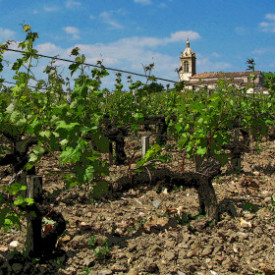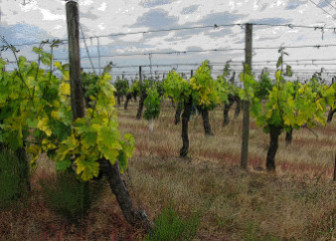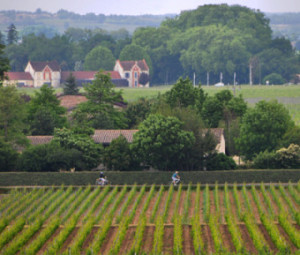Bordeaux Grape Varieties; Comfort Food For The Oenophile.
Chapter Sixteen. Part Five.
California winemakers like to imitate the French. No, they’re not on strike. In an attempt to mimic the classic wines of Bordeaux, they often blend Cabernet Sauvignon, Merlot, Cabernet Franc, Petit Verdot and Malbec (the main varieties found in red Bordeaux wine), then they take a 3-hour lunch and go on strike.
Hey, I’m kidding. It’s what I do. I poke fun at my friends which probably explains why my Facebook page only has unfriend and unlike buttons. Seriously, many of these Bordeaux imitations are very elegant, feminine wines – in an unshaven sort of way.
When the Californians couldn’t decide what to call these blended wines, they held a contest and came up with the name Meritage. The term is also a blend, this time between merit and heritage, which taste pretty bland on their own. The name is designed to project the high quality of the grapes and the rich history of Bordeaux wines.
The wines of Bordeaux are almost always a blend of different grape varieties. Early Bordelais vignerons learned that the deficiencies inherent in one variety can be overcome through blending, and a more complete, complex wine can result. Merlot added to Cabernet Sauvignon for example, has a softening effect, while Petit Verdot adds color, body and floral aromas. I could be wrong but I think Cabernet Franc is just some guy who hangs around the tasting room.
Despite the benefits of blending, the practice actually grew out of necessity and not some ancient alchemists desire to create the perfect wine in a laboratory. Bud break, flowering and ripening occur at different times for each grape variety and as a result an outbreak of treacherous weather may reap havoc with one variety but not the other. This gives the winemaker options if one variety suffers in a difficult vintage. In this regard grapes are a lot like children; you just throw away the rotten ones.
The most common red wine grapes grown in Bordeaux are Merlot, Cabernet Sauvignon and Cabernet Franc. A small percentage of the spicy grape Petit Verdot is sometimes added to the blend – much like a chef adds spice to his creations. Ironically the traditional grapes Malbec and Carmenère are falling out of favor in Bordeaux just as they are skyrocketing in popularity in Argentina and Chile.
As you float westward down the river Gironde towards the Atlantic Ocean, the Bordeaux vineyards on your right are ingeniously referred to as the right bank. St.-Emilion and Pomerol are situated on these northeastern shores, while the appellations made famous in the 1855 Bordeaux Classification (Pauillac, St. Estèphe, St. Julien, Margaux, Graves) are located on the left bank.
On the right bank, Merlot and Cabernet Franc reign supreme, complemented by smaller plantings of Cabernet Sauvignon. The left bank is predominantly Cabernet Sauvignon country, with Merlot and small plots of Cabernet Franc also grown.
The white wines of Bordeaux are typically produced from Sémillon, Sauvignon Blanc and Muscadelle. The other permitted white varieties are Sauvignon Gris, Ugni Blanc, Colombard, Ondenc, Merlot Blanc (an offspring of Merlot), and Mauzac (an offspring of Harold and Gertrude).
Sémillon, Sauvignon Blanc and Muscadelle are polite grapes that complement each other when blended. They can produce dry wine or very sweet wines when the grapes are infected with Botrytis Cinerea (the noble rot needed to concentrate the grape sugars).
Sémillon is a thin-skinned grape that adds weight and fig-like flavors when blended with Sauvignon Blanc to make dry wine. It is more commonly used for sweet wine production because noble rot can easily pierce the thin skin surface. The microscopic holes created allow water to escape which increases the sugar concentration.
Sauvignon Blanc is the second most common white varietal and is often used to produce an unblended dry wine. Its high acidity however makes it blend well with Sémillon. On its own Sémillon can be a little flabby around the middle which gives us something in common.
Smaller amounts of Muscadelle are often blended into both the dry and sweet wines for its grapey, floral characteristics. Muscadelle goes by many names including Cadillac, but in this neck of the woods it’s treated more like a KIA.
I mentioned that I only have unfriends who unlike me but that’s not entirely true. Bordeaux is an old friend that has been with me since the beginning of my love affair with wine. (Well, there was that apple wine phase in high school but I had hormones raging through my body so I can’t be held accountable.) Of course there were others through the years. There was that crazy, passionate thing with Shiraz when I was young and experimental. Relationships with
Chardonnay, Zinfandel and Sangiovese have come and gone. I have sniffed, swirled, savored and spat my way through countless wine affairs. Some were lasting relationships but many were meaningless one-night stands. Believe me, I felt terrible in the morning.
Through it all my Bordeaux collection lay quietly in my wine cellar waiting for me to come home. Today, opening one of these patient bottles of Bordeaux is like returning to the arms of an old lover. I find myself sliding back into comfortable patterns; I swirl, I sip, and I smile at the meaning and memory in every drop. Bordeaux is like that beautiful French lover who is always there to welcome you home with open arms and hairy legs.
























Great post! Wine is so easy to understand when you break it down like that! Cheers!
Thanks Sean. I thought it was time to get back to the bones of this blog – the basic story of wine appreciation – and take a break from the fart jokes.
Please don’t stop with the fart jokes. They never get old.